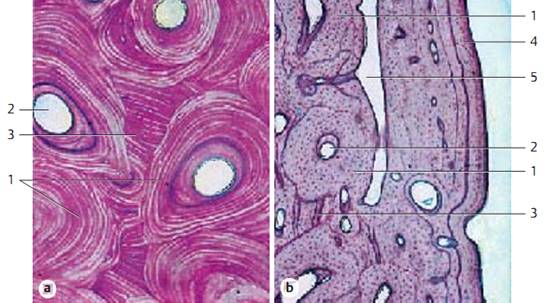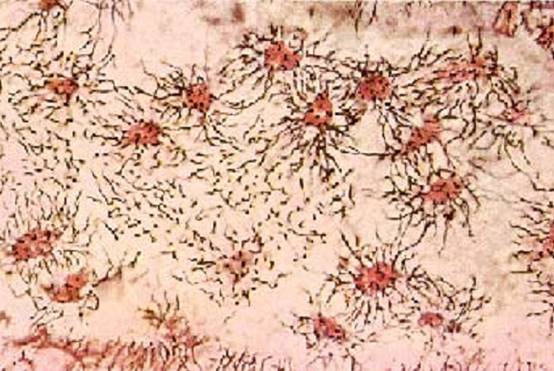


 النبات
النبات
 الحيوان
الحيوان
 الأحياء المجهرية
الأحياء المجهرية
 علم الأمراض
علم الأمراض
 التقانة الإحيائية
التقانة الإحيائية
 التقنية الحيوية المكروبية
التقنية الحيوية المكروبية
 التقنية الحياتية النانوية
التقنية الحياتية النانوية
 علم الأجنة
علم الأجنة
 الأحياء الجزيئي
الأحياء الجزيئي
 علم وظائف الأعضاء
علم وظائف الأعضاء
 الغدد
الغدد
 المضادات الحيوية
المضادات الحيوية|
Read More
Date: 17-1-2017
Date: 3-8-2016
Date: 4-8-2016
|
Bone Tissue-Compact Bone
Transverse section of an osteon with its Haversian canal 1 . It is enveloped by lamellae in the ground substance, which may be more or less impregnated with Silver nitrate. The collagen fibers in the more heavily stained lamellae are arrange d in a circular fashion; in the lightly stained areas, their orientation follows the longitudinal axis of the osteons. The black spindle-shaped structures with numerous fine black threads extending from their surfaces are osteocytes 2 and their cellular projections. The osteocytes reside in bone cavities, and their projections reach into the bone canals.
1 Haversian canal
2 Osteocytes
Stain: silver nitrate impregnation; magnification: × 250

Bone Tissue—Compact Bone
All osteons 1 with their special lamellae and the interstitial lamella systems 3 are encased by the outer and inner general lamellae 4 . Figure b shows the outer general lamella 4 . The oblong narrow space represents a vascularized Volkmann canal ( transverse canal ) 5 . These transverse canals break through the lamella systems. Different lamella systems are separate d by cement lines. These consist of ground substance with a few fibrils, and they stain heavily with hematoxylin.
1 Osteon
2 Haversian canal
3 Interstitial lamella
4 Outer general lamella
5 Volkmann canal
Stain: hematoxylin-eosin; magnifications: a) × 120, b) × 10

Bone Tissue—Compact Bone
Cross-section (a) and transverse section (b) through an osteon, demonstrating the lacunae (bone cavities, lacunae osseae) and the bone channels (canaliculi ossei). The bone canaliculi cannot be seen in the usual histological preparations. Canaliculi are about 1.0–1.5 μm wide and are devoid of extracellular matrix.
They contain many branched, filopodia-like osteoplast projections. Bone canaliculi of neighboring bone cavities interconnect. The system of canals serves for the exchange of materials between osteocytes and extracellular space. Osteocytes are spindle-shape d cells with long, slender, interconnecting cell projections.
Stain: Schmorl thionine-picric acid; magnification: × 400

Bone Tissue—Compact Bone
Decalcified bone tissue can be processed like any other tissue. It can be cut using a microtome and stained. The cytoplastic processes of osteoplast occupy bone canals in the extracellular space and connect with each other via nexuses. The exchange of materials probably proceeds via these cytoplasmic processes.Osteocytes and their cytoplasmic processes (projections) are clearly visible in thin sections of compact bone substance from the femur after decalcification and Schmorl staining.
Stain: Schmorl thionine-picric acid; magnification: × 500

References
Kuehnel, W.(2003). Color Atlas of Cytology, Histology, and Microscopic Anatomy. 4th edition . Institute of Anatomy Universitätzu Luebeck Luebeck, Germany . Thieme Stuttgart · New York .



|
|
|
|
علامات بسيطة في جسدك قد تنذر بمرض "قاتل"
|
|
|
|
|
|
|
أول صور ثلاثية الأبعاد للغدة الزعترية البشرية
|
|
|
|
|
|
|
العتبة الحسينية تطلق فعاليات المخيم القرآني الثالث في جامعة البصرة
|
|
|